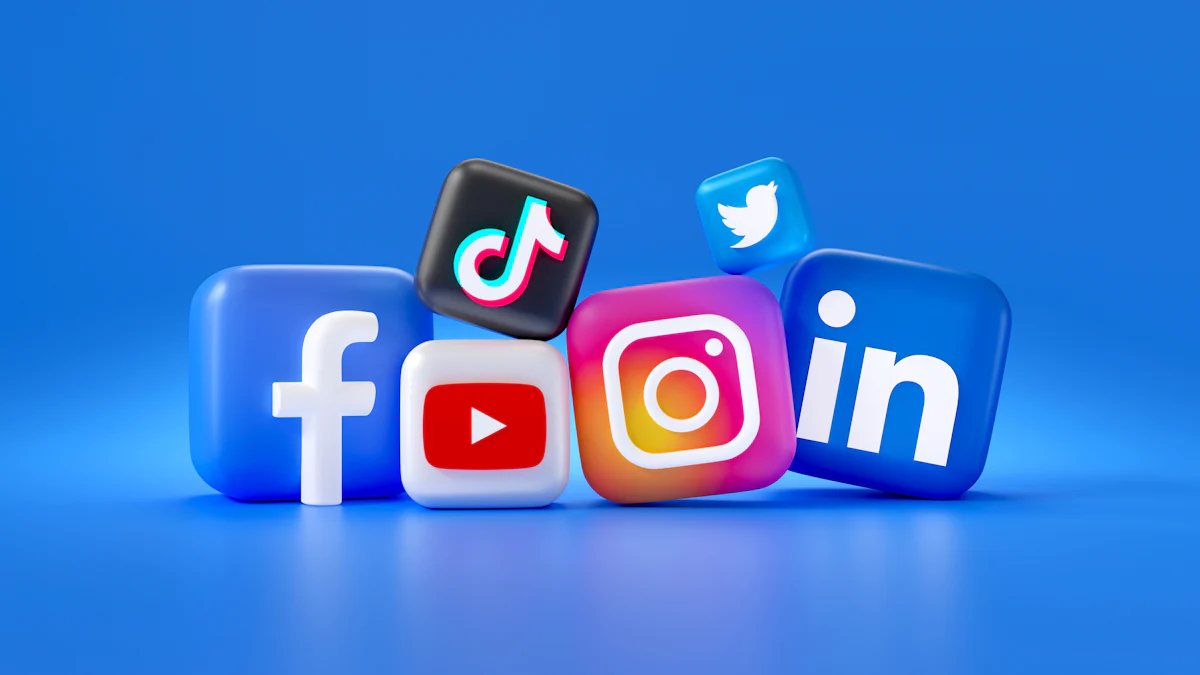Why Influencer Marketing Platforms Are Crucial for E-commerce in 2025

In 2025, influencer marketing web platforms are transforming how you connect with your audience in ecommerce. These tools empower you to collaborate with influencers effortlessly, ensuring your campaigns deliver measurable success. With the rise of social commerce, consumers now shop directly through social media, creating a seamless experience that boosts your brand's visibility.
The numbers speak for themselves. Spending on influencer marketing is projected to grow from $8.14 billion in 2024 to $9.29 billion in 2025, a 14.2% increase. Over half of brands working with influencers already operate ecommerce stores, proving the undeniable link between these influencer marketing web platforms and your business's success. By embracing this shift, you position yourself to thrive in a competitive market.
Understanding Influencer Marketing Platforms
What Are Influencer Marketing Platforms?
Influencer marketing platforms are your ultimate ally in navigating the influencer marketing industry. These platforms simplify the process of connecting with influencers and managing campaigns. They offer a range of influencer marketing tools designed to make your life easier. For example:
- Discovery tools help you find influencers who align with your brand and evaluate their performance.
- Outreach features allow you to connect and negotiate with influencers directly.
- Relationship management tools enable you to build long-term partnerships.
- Dashboards provide real-time insights into campaign performance and forecasts.
- Automation features streamline repetitive tasks, saving you time and effort.
With a user-friendly interface and access to an extensive influencer database, these platforms empower you to create impactful campaigns. Strong reporting and analytics tools ensure you can measure success and make data-driven decisions.
The Role of Influencer Marketing in Ecommerce
In ecommerce, influencer marketing plays a pivotal role in driving sales and building trust. Here’s how it helps:
- Expanded Reach: Influencers introduce your brand to new demographics, broadening your audience.
- Authenticity and Trust: Their endorsements feel genuine, encouraging customers to trust your products.
- Enhanced Brand Awareness: Collaborations generate buzz, making your brand more visible to potential buyers.
By leveraging influencer marketing web platforms, you can tap into these benefits and create a lasting impact on your audience.
Why They Are Vital for Ecommerce in 2025
The ecommerce landscape in 2025 is more competitive than ever. Influencer marketing platforms address key challenges, such as influencer fraud and the difficulty of measuring ROI. They also help you stand out in a saturated market by enabling data-driven decisions and fostering long-term influencer relationships.
Social commerce continues to rise, with consumers expecting seamless shopping experiences. Influencer marketing web platforms empower you to meet these expectations by integrating shoppable content into campaigns. This approach not only boosts sales but also strengthens your brand’s connection with its audience.
To thrive in 2025, you need to embrace these platforms. They are the cornerstone of effective ecommerce content marketing, helping you stay ahead of trends and achieve sustainable growth.
Benefits of Influencer Marketing Platforms for Ecommerce

Boosting Brand Visibility
You want your ecommerce brand to stand out in a crowded marketplace. Influencer marketing platforms make this possible by connecting you with influencers who can amplify your reach. When you collaborate with influencers, your brand gains exposure to their loyal followers. For instance:
- A campaign involving 45 influencers reached over 980,071 consumers directly.
- This effort resulted in over 10,000 new social media followers.
- Influencer marketing delivers an 11x higher ROI compared to traditional digital marketing.
These platforms help you create campaigns that generate buzz and drive traffic to your online store. By leveraging influencer partnerships, you can transform your ecommerce content marketing strategy into a powerful tool for growth.
Building Customer Trust and Authenticity
Building customer trust is essential for long-term success. Influencers excel at creating authentic connections with their audiences, which translates into trust for your brand.
Authentic influencers stay true to their values, increasing credibility with their followers. This encourages engagement and motivates purchases based on their recommendations.
Here’s why this matters:
- 92% of consumers trust influencer recommendations over traditional ads.
- Genuine connections foster loyalty and improve customer retention.
- Transparency in influencer campaigns leads to better conversions.
Micro-influencers and niche influencers are particularly effective. Their smaller, engaged audiences trust their opinions, making them ideal for promoting your products. This approach enhances the customer experience and builds lasting relationships.
Achieving Higher ROI
Influencer marketing platforms enable you to achieve higher ROI by optimizing your campaigns. Brands like Scotch & Soda and LOOKFANTASTIC have seen remarkable results:
| Brand | Strategy Description | Outcomes |
|---|---|---|
| Scotch & Soda | Used top-tier and micro-influencers to target younger audiences. | Increased followers, higher engagement, and better reach to younger demographics. |
| LOOKFANTASTIC | Partnered with micro-influencers for authentic reviews. | Boosted fanbase, user-generated content, and accelerated sales. |
| ABN AMRO | Collaborated with macro-influencers to promote local businesses. | Improved visibility, loyalty, and significant growth in card usage. |
These examples show how influencer marketing drives traffic, boosts conversions, and enhances customer retention. By using these platforms, you can track performance, refine strategies, and maximize your ROI.
Simplifying Campaign Management
Managing influencer campaigns can feel overwhelming, especially when juggling multiple influencers, platforms, and deadlines. Influencer marketing platforms simplify this process, giving you the tools to stay organized and efficient. These platforms act as your command center, streamlining every aspect of campaign management so you can focus on growing your ecommerce business.
You can use these platforms to centralize communication with influencers. Instead of managing endless email threads or direct messages, you’ll have a single space to coordinate collaborations. This keeps everything clear and ensures nothing slips through the cracks. Many platforms also offer automated workflows, helping you save time by handling repetitive tasks like sending reminders or tracking deliverables.
Tracking campaign performance becomes effortless with built-in analytics dashboards. You’ll gain real-time insights into metrics like engagement rates, conversions, and ROI. This data empowers you to make informed decisions and adjust strategies on the fly. For example, if a particular influencer’s post is underperforming, you can quickly pivot to optimize results.
Budget management is another area where these platforms shine. You can set spending limits, monitor expenses, and ensure campaigns stay within budget. This level of control helps you maximize the impact of your investment in ecommerce content marketing.
By simplifying campaign management, these platforms free up your time and energy. You’ll be able to focus on creating meaningful connections with your audience and scaling your ecommerce brand. With the right tools, managing influencer campaigns transforms from a daunting task into an exciting opportunity to grow your business.
Tip: Choose a platform that aligns with your goals and offers features tailored to your needs. The right choice can elevate your content marketing for ecommerce and drive long-term success.
Trends in Influencer Marketing for 2025

AI-Driven Influencer Marketing Web
Artificial intelligence is revolutionizing the influencer marketing industry, making campaigns smarter and more effective. In 2025, AI tools will help you match with influencers who align perfectly with your brand values. These tools analyze vast amounts of data to identify influencers with the right audience, ensuring your message reaches the people who matter most. AI also optimizes campaigns by predicting trends and providing real-time insights, so you can make informed decisions quickly.
Virtual influencers are another exciting trend. These AI-generated personalities offer a unique way to connect with audiences while avoiding real-world controversies. Over 60% of brands have already embraced virtual influencers, and this number is expected to grow. You can also leverage AI-driven personalization to create tailored content that resonates with your audience. By delivering the right message at the right time, you’ll enhance user engagement and improve your overall marketing effectiveness.
Live shopping is gaining momentum as well. Influencers host interactive sessions where they showcase products in real-time, creating an engaging experience for viewers. This trend combines the power of video with the convenience of social commerce, making it easier than ever for consumers to shop directly from their favorite platforms.
Micro-Influencers and Niche Audiences
Micro-influencers are transforming how you connect with your audience. These influencers, with 10,000 to 50,000 followers, have built strong personal connections with their communities. Their authenticity fosters trust, making them ideal for promoting your products. In fact, engagement rates among micro and nano-influencers often surpass those of larger influencers, giving you access to highly responsive audiences.
Collaborating with micro-influencers allows you to target niche audiences effectively. Their followers share specific interests, ensuring your message resonates deeply. This approach is also cost-effective, enabling you to scale campaigns without stretching your budget. In 2025, long-term partnerships with micro-influencers will become the norm. These collaborations emphasize authenticity and relevance, helping you build lasting relationships with your customers.
By focusing on micro-influencers, you can create campaigns that feel genuine and relatable. Their ability to connect on a personal level makes them a powerful asset in your ecommerce strategy.
Data-Driven Campaigns in Ecommerce
Data is the backbone of successful influencer marketing campaigns. In 2025, you’ll rely on data-driven strategies to maximize your ROI. Tools like tracking links and unique discount codes allow you to measure the effectiveness of each influencer. For example, a beauty brand used attribution tools to track sales from 10 influencers. The data revealed that micro-influencers delivered higher conversion rates, leading the brand to double its ROI by focusing on them.
To succeed, you need to monitor key performance indicators such as engagement rates, click-through rates, and conversions. This data helps you understand what works and what doesn’t, so you can refine your approach. Personalisation through data will also play a crucial role. By analyzing user behavior, you can deliver tailored messages that resonate with your audience, enhancing their shopping experience.
Interactive and video content will dominate in 2025. Videos allow you to showcase your products in action, creating a dynamic and engaging experience for viewers. Combined with data insights, this approach ensures your campaigns are both impactful and efficient.
Tip: Use data to guide your decisions and focus on strategies that deliver measurable results. This approach will help you stay ahead in the competitive ecommerce landscape.
Social Commerce and Shoppable Content
Social commerce is revolutionizing how you sell products online. In 2025, it’s no longer just about showcasing your products—it’s about creating seamless shopping experiences directly on social platforms. Platforms like Instagram, TikTok, and Pinterest now offer shoppable content that allows your customers to purchase without ever leaving the app. This trend is reshaping e-commerce, making it more interactive and customer-focused.
Shoppable content bridges the gap between inspiration and action. Imagine a customer scrolling through Instagram and seeing a post featuring your product. With just one tap, they can view details, add it to their cart, and complete the purchase. This frictionless process reduces drop-off rates and boosts conversions. You’re not just selling a product—you’re offering convenience and instant gratification.
Tip: Use high-quality visuals and engaging captions to make your shoppable posts stand out. A compelling story behind your product can inspire customers to take action.
Here’s why social commerce and shoppable content are game-changers for your e-commerce strategy:
- Increased Engagement: Interactive posts keep your audience engaged longer.
- Higher Conversion Rates: Simplified purchasing paths lead to more sales.
- Enhanced Brand Loyalty: Customers appreciate the ease of shopping directly on their favorite platforms.
Live shopping events are another exciting trend. Influencers host live streams where they showcase your products, answer questions, and provide exclusive discounts. This creates a sense of urgency and excitement, driving immediate sales.
Note: Partner with influencers who align with your brand values. Their authenticity will amplify your message and build trust with your audience.
By embracing social commerce and shoppable content, you can transform your e-commerce business. You’ll connect with your audience in meaningful ways, inspire them to act, and create a shopping experience they’ll love. The future of e-commerce is here—are you ready to lead the way?
Steps to Build an Effective Ecommerce Content Marketing Strategy
Setting Clear Campaign Goals
Setting clear goals is the foundation of any effective ecommerce content marketing strategy. Without a roadmap, your influencer campaigns may lack direction and fail to deliver results. To create impactful goals, follow these steps:
- Be specific. Define exactly what you want to achieve, whether it’s increasing sales, boosting brand awareness, or growing your social media following.
- Make your goals measurable. Use metrics like engagement rates, click-through rates, or conversions to track progress.
- Keep them achievable. Set realistic targets that align with your resources and capabilities.
- Ensure relevance. Your goals should align with your brand identity and overall marketing objectives.
- Set a timeline. Assign deadlines to keep your campaigns on track and maintain momentum.
Before you start, ask yourself key questions: Who is your target audience? What makes your brand unique? What resources can you allocate? Answering these will help you craft a focused influencer marketing strategy that drives results.
Choosing the Right Influencer Marketing Platform
The right platform can make or break your influencer campaigns. To choose wisely, assess your business needs and goals. Are you looking to increase visibility, drive sales, or both? Once you know your priorities, compare platforms based on their features and pricing. Look for tools that simplify influencer discovery, campaign management, and performance tracking.
Ease of use is critical. A user-friendly interface saves time and reduces frustration. Also, consider how well the platform integrates with your existing tools, such as your e-commerce store or social media channels. Strong customer support is another factor to evaluate. A responsive support team can help you resolve issues quickly, ensuring your campaigns run smoothly.
By selecting a platform that aligns with your goals, you’ll streamline your workflow and maximize the impact of your influencer marketing efforts.
Collaborating with Influencers
Collaboration is the heart of any successful influencer campaign. Start by setting clear guidelines. Define your goals, expectations, and deliverables upfront to avoid misunderstandings. While structure is important, give influencers creative freedom. Their unique voice and style resonate with their audience, making the content more authentic and engaging.
Diversify your creator mix. Partner with influencers from different industries to reach new audiences. For example, Subaru’s #MeetAnOwner campaign showcased authentic experiences through influencer content, generating over 1.3 million views. This highlights the power of relatable storytelling.
Encourage user-generated content. When influencers inspire their followers to share their own experiences, it creates a sense of community and trust around your brand. Leverage multiple social media platforms to maximize reach and engagement.
By fostering strong partnerships, you’ll create campaigns that not only drive sales but also build lasting connections with your audience.
Measuring Campaign Success
Measuring the success of your influencer marketing campaigns is essential. It helps you understand what works and where to improve. Without tracking performance, you risk wasting time and resources. By focusing on key metrics, you can ensure your campaigns deliver the results you need.
Start by identifying the right metrics for your goals. If you aim to increase brand awareness, track impressions, reach, and engagement rates. For driving sales, monitor conversions, click-through rates, and revenue generated. Use tools like Google Analytics or platform-specific insights to gather this data.
Tip: Assign unique tracking links or discount codes to each influencer. This makes it easier to attribute sales and traffic to specific campaigns.
Engagement is a critical indicator of success. High likes, comments, and shares show that your audience connects with the content. However, don’t stop there. Dive deeper into the quality of interactions. Are followers asking questions or sharing their experiences? These meaningful engagements often lead to stronger customer relationships.
ROI (Return on Investment) is another key metric. Calculate it by comparing the revenue generated to the cost of the campaign. For example, if you spent $5,000 and earned $15,000, your ROI is 200%. A positive ROI confirms that your strategy is effective.
Create a post-campaign report to analyze your results. Include data, insights, and lessons learned. This helps you refine future campaigns and build on your successes.
Note: Success isn’t just about numbers. Consider the long-term impact, like increased brand loyalty or improved customer trust. These intangible benefits often lead to sustained growth.
By measuring success effectively, you gain clarity and confidence. You’ll know exactly how your efforts contribute to your e-commerce goals. This empowers you to make smarter decisions and achieve even greater results.
Influencer marketing platforms are transforming how you grow your e-commerce business. They give you tools to enhance visibility, build trust, and achieve higher ROI. By 2025, these platforms will be essential for staying competitive. Consumers value authenticity, and influencers who align with your brand values can create meaningful connections with your audience.
To thrive, focus on long-term partnerships with influencers. These relationships foster consistency and trust, making your brand a natural part of their lives. Advanced technologies and data analytics will also shape the future of influencer marketing. By adopting these platforms now, you can future-proof your business and deliver an exceptional shopping experience to your customers.
Long-term relationships with influencers lead to consistency and authenticity, allowing brands to integrate their messages organically into the influencers' lives.
FAQ
What is the best way to find the right influencers for my brand?
Use influencer marketing platforms to discover influencers who align with your brand values. These platforms provide filters for niche, audience demographics, and engagement rates. Focus on authenticity and relevance to ensure their followers connect with your products.
Tip: Look for influencers who already share content related to your industry.
How can I measure the success of my influencer campaigns?
Track key metrics like engagement rates, conversions, and ROI. Use tools like unique discount codes or tracking links to attribute sales. Analyze post-campaign reports to refine your strategy and improve future results.
Note: Success isn’t just about numbers. Consider long-term benefits like customer loyalty.
Are micro-influencers better than macro-influencers for ecommerce?
Micro-influencers often deliver higher engagement rates and connect deeply with niche audiences. They’re cost-effective and ideal for building trust. Macro-influencers, however, offer broader reach. Choose based on your campaign goals and budget.
Tip: Combine both types for a balanced strategy that maximizes reach and authenticity.
How do I ensure my influencer campaigns feel authentic?
Give influencers creative freedom to craft content in their unique style. Authenticity comes from genuine storytelling and relatable experiences. Avoid overly scripted campaigns that feel like ads.
Reminder: Trust the influencer’s expertise in engaging their audience.
What trends should I focus on for influencer marketing in 2025?
Prioritize AI-driven tools, micro-influencers, and shoppable content. Embrace live shopping events and data-driven personalization. These trends enhance engagement and create seamless shopping experiences for your audience.
Pro Tip: Stay updated on emerging technologies to keep your campaigns innovative and effective.
See Also
Essential Influencer Marketing Tools for E-commerce Growth
15 Must-Have Influencer Marketing Platforms for 2024
Key Influencer Marketing Trends to Follow in 2024
Navigating Influencer Marketing Tools for Small Enterprises
Affordable Influencer Marketing Platforms to Consider in 2024
